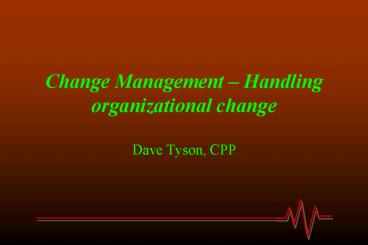Change Management Handling organizational change PowerPoint PPT Presentation
1 / 18
Title: Change Management Handling organizational change
1
Change Management Handling organizational change
- Dave Tyson, CPP
2
Agenda
- Building organizational capacity to change
- Identify the key success factors in change
management process - Investigate each step and its significance
- Apply that to the real world
3
Building capacity to change
- Identify key success factors for building
capacity to change - Profile the extent to which these key success
factors are being managed - Identify improvement activities for each success
factor - See the seven key success factors as an iterative
process, not an event
4
Step 1 -Key success factors in change management
process
- Leading change
- Creating a shared need
- Shaping the vision
- Mobilizing commitment
- Modifying systems structures
- Monitoring progress
- Making it last
5
Leading Change who is responsible?
- Do we have a leader?
- Who owns the change?
- Who publicly commits to making it happen?
- Who will garner the resources necessary to
sustain it?
6
Creating a shared need Why do it?
- Do employees
- See the reason for change
- Understand why the change is important
- See why it will help them or the business in the
short / long term
7
Shaping a vision what will it look like when we
are done?
- Do employees
- See the outcomes of change in behavioural terms
in terms of what they will do differently as a
result of the change - Get excited about the results of accomplishing
the change - Understand and are able to communicate how the
change will benefit customers and other
stakeholders
8
Mobilizing commitment who else needs to be
involved?
- Do the sponsors of the change
- Recognize who else needs to be committed to the
change to make it happen - Know how to build a coalition of support for the
change - Have the ability to enlist the support of key
individuals in the organization - Have the ability to build a responsibility matrix
to make the change happen
9
Modifying existing systems structures how
will be institutionalized?
- Do the sponsors of change
- Understand how to link the change to other HR
systems i.e. staffing, training, performance
appraisal - Recognize the systems implications of the change
and their impact on the organization
10
Monitoring progress how will it be measured?
- Do the sponsors of the change
- Have a means of measuring the success of the
change - Plan to benchmark progress on both the results of
the change and the process of implementing the
change - Systems focus long term development
11
Making it last how will it get started and last?
- Do the sponsors of change
- Recognize the first steps in getting started
- Have short and long term plans to keep attention
focused on the change - Have a plan for adapting the change over time
12
Step 2- Profiling questions regarding capacity to
change
13
Step 3 - Identify improvement activities for each
success factor
- Focused on transformation building the capacity
to change through key success factors - E.Gs
- Shaping a vision move from articulating the
future to making it real for everyone - Mobilizing commitment move from getting their
cooperation to gaining their commitment
14
Step 4 - See the seven key success factors as an
iterative process, not an event
Leading Change
Making change last
Creating a shared need
Monitoring Progress
Shaping a vision
Changing Systems Structures
Mobilizing Commitment
15
Why changes dont produce results
- Not tied to strategy
- Seen as a fad or quick fix
- Short term perspective
- Political realities undermine change
- Grandiose expectations versus simple success
- Inflexible change decisions
- Lack of leadership about change
- Lack of measurable tangible results
- Afraid of the unknown
- Unable to mobilize commitment to sustain change
16
Challenges to change
- What percentage of people reach their target
weight in weight watchers? - What percentage maintain their target weight
forever? - What percentage of people stop smoking and never
start again - What percentage of people stop smoking and never
start again after a major physical crisis - What percentage of re-engineering or quality
changes are judged to be a success
17
Challenges to change
- What percentage of people reach their target
weight in weight watchers? 5 - What percentage maintain their target weight
forever? .5 - What percentage of people stop smoking and never
start again? 17 - What percentage of people stop smoking and never
start again after a major physical crisis? 43 - What percentage of re-engineering or quality
changes are judged to be a success? 25
18
Questions - Thanks
- Dave Tyson, CPP
- Chief Operating Officer
- FYP Corporate Threat Management
- (604) 646-4081
- dtyson_at_fyp.ca

